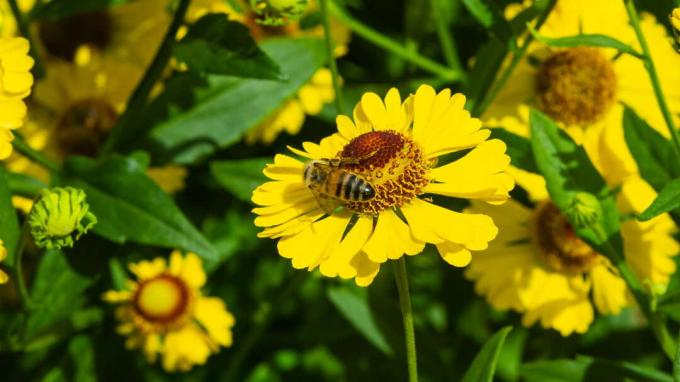Colorful summer flowers and delicious vegetables can not only make you happy, but also the bees. We give you tips about bee-friendly seeds.

Active protection of bees is promoted by nature conservation associations and politicians, since bees not only affect beekeepers and agriculture, but also the health of entire ecosystems. An important area of bee protection is the supply of different bee forage plants. There are also varieties among annual summer flowers and vegetables that encourage bees. This article therefore deals with bee-friendly seeds in the following and explains why it makes sense to use them.
contents
- What does "bee friendly" mean?
- Why is bee-friendly seed important?
- Which bees are threatened?
- What should you look out for when buying seeds?
What does "bee friendly" mean?
Fly bees When you see a colorful flower, you expect a calyx with stamens and pollen, from which you can take nectar. In return, they carry the pollen in their hair or on other parts of their body to the next flower. Bee-friendly plants - or "bee food plants" - are accessible to bees, have a lot of nectar and bloom particularly often or for a long time. Plants that can give nectar at special times are also very "bee-friendly". After all, in early spring and autumn, food sources for bees can be difficult to find. The complementary flowering times of different bee forage plants thus ensure the nutrition of the bees over the entire vegetation period.
But it can happen that the flower that is being controlled does not hold any nectar for the bee at all: some Garden plants are simply too exotic and their flower structure is designed in such a way that bees cannot eat the nectar reachable. Many ornamental plant varieties are sterile through breeding, they lack pistils, stamens, pollen and nectar. Agricultural cultivation in monocultures is also not bee-friendly. This means that only a few plant species can be found in the catchment area for the bees. This becomes a problem if these do not cover the entire flight period of the bees (February to October). Also, feeding on only one type of pollen is not very beneficial for bees.

Summary: What does "bee-friendly" mean?
- Bee-friendly are plants whose nectar is accessible to bees, which flower for a long time, produce a lot of nectar or which offer food for bees at special times.
- The flowering period of bee forage plants should cover the entire foraging period of the bees.
- Plants whose flowers are not accessible to bees or which do not provide nectar cannot be used by bees. Bees also do not get too one-sided or irregular nutrition from large-scale monocultures.
Why is bee-friendly seed important?
Beekeepers and agriculture, including fruit and vegetable growing, are dependent on honey and wild bee populations being as stable and healthy as possible. Together with bumblebees, it is their pollination that makes fruit set possible. Without pollination, many plants do not reproduce and therefore do not produce fruit. The honey bee pollinates about 80% of local crops. Both honey bees and wild bees are therefore an irreplaceable and indispensable factor for our agriculture and nutrition.
However, various factors are threatening both honey bee and wild bee populations. One factor is the monocultures mentioned above and the "cleared" cultural landscapes, which only show a low diversity of bee forage plants. Sowing bee-friendly seeds can help encourage honey bees and wild bees. Why is it generally useful Bees in your own garden to support, you can read about it here.

Tip: Providing fodder plants is a step in the right direction. But if you want to go a little further and actively protect bees, you can get tips for a bee here Bee paradise in the garden to fetch. Or you can get advice from a hobby beekeeper and find out how you can bees in the garden promote and protect more comprehensively. Particularly committed people can also apply from 1 April 2019 to Nationwide planting competition of the initiative "Germany buzzes" Sign in.
Which bees are threatened?
While honey bees now have a huge circle of supporters in the form of beekeeping, the Unfortunately, the wild bees often have agriculture and now also politics behind them overlook. The honey bee doesn't have it easy, but due to its important status, it is so strongly promoted that its complete extinction is hardly an option. However, nature is by no means dependent on the honey bee, wild bees could also carry out pollination. These are often even disadvantaged and further decimated by the honey bee’s collection work. For this reason, the protection of wild bees should also be given greater focus.
What should you look out for when buying seeds?
When purchasing any seeds, keep the following in mind:
- Does the plant that emerges from the seed yield nectar at all? For bees, of course, only those plants that reproduce through insect pollination are important. Everything that is colorful and fragrant is interesting for bees.
- Does the seed bear a mark identifying it as a bee food plant, or is an alternative available with the same mark? Many seed dealers refer to particularly bee-friendly plant varieties.
- Wouldn't seeds from native plants be a good alternative? The native wild bees are best adapted to these.
- Does the seed cover the entire bee flight season (February to October)?
- Is the seed suitable for the location where you sow it?
Our Plantura bee pasture meets all of these criteria. It contains more than 20 annual and perennial proven species that provide bees with a rich supply of food. The easy-care mixture can simply be sown in the bed or in the balcony box.

